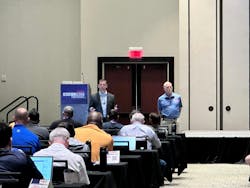2025 Station Design Conference Paved Path for Innovative Stations in the Future
At the 2025 Station Design Conference last month, attendees learned quickly it was a "working" conference, with more than 60 presentations offered by 81 public safety end-users and architectural specialists. There was one track on initial steps for fire and law enforcement departments who are designing a new station while three other tracks covered progressive programs, the hottest trends and innovations in public safety facilities.
This year, the pre-conference program included two programs for volunteer departments that are designing stations. One program, "Volunteer Stations, Big Impact: Shaping the Modern Volunteer Fire Station, was presented by Michael Petrovick.
“Volunteer fire departments deserve and can achieve modernization with the right approach,“ said Petrovick, of Michael Petrovick Architects.
Petrovick explained that designing the right-sized volunteer fire station involves four key components:
- Community engagement
- Safety first
- Code compliance
- Creative design
Creative design in a volunteer fire station is important because it can maximize impact on multi-purpose spaces, training options, and operational responses. The ability to incorporate flexible interiors supports the building's future growth and longevity.
Several years ago, "How to Afford a 75-Year Facility without Busting the Budget" was introduced by Ken Newell, of Stewart-Cooper-Newell Architects. The idea of building a fire station or public safety facility to last 75 years today is even more realistic to achieve.
Based on the standing-room-only attendance for Newell’s presentation, interest in building for longevity is gaining popularity.
“Statistics show the average age of an operating fire station in the U.S. is 48 years old,” he said. Construction costs are at an all-time high and will continue to rise, as will technology, training and operational costs.
Among the ways to achieve station longevity are multi-use and flexible spaces, maintenance-free and durable finishes, and additional add-ons.
The keynote address, "Next Generation Public Safety Facilities," by Patrick Stone and Dennis Ross of H2M architects + engineers, is best summarized by its focus on technology, operational advancements, health, and safety.
Advances in electric fleets, particularly the use of drones, will continue to progress, including for real-time surveillance, aerial assessments and even EMS-related calls. Another reality is the increase of robotics in incident response. Numerous cities currently have robots, and the versatility is expanding. Questions for station design involves the location of power sources, storage, and transport of these items.
The focus on advanced technology continued. In "State of the Art Security and Technology," featuring Ted Galante of The Galante Architecture Studio and Geva Borash of Secure Our City, Inc., they delved into the issues of increasing civil unrest and man-made and natural disasters.
Current vulnerabilities in fire stations are outdated station technology and a lack of technology integration. Surveillance in and around the fire station continues to advance, with higher-resolution images of the interior and exterior of the facility, reduction of exterior communication cables and continuous updates to cybersecurity.
The impact of artificial intelligence (AI) on the fire service and public safety was frequently mentioned in many sessions, emphasizing the importance of this job-changing technology.
Another significant pending change in the fire service will be the consolidation of seven NFPA standards into a single one. Roger LeBoeuf, of Elliott, LeBoeuf & McElwain, P.C., and Brent Norwine, Assistant Chief, CAL FIRE/San Mateo, explained the pending changes in NFPA 1400: Standard on Fire Service Training, Impacts Training Facilities and Training Operations.
The consolidation includes NFPA Standards 1402, 1403, 1404, 1407, 1408, 1410, and 1451. NFPA 1400 applies to all new and existing fire training structures and props, whether at training centers, fire stations, or elsewhere.
One of the last programs of the conference on Thursday morning, Fire Stations: A Million and Three Little Details You Can’t Afford to Overlook," featured award-winning architects, Ray Holliday and Ashton Holliday, of BRW Architects.
“The more options you’re aware of, the better decisions you can make for your station,” said Ray. Among their years of experience and lessons learned, the duo offered over two dozen recommendations, including:
- A minimal slope to the trench drain allows water to drain, but doesn’t create a tripping hazard
- Add more circulation space between the truck and a wall for clearances when doors are open
- Sleeping rooms should include sound insulation between rooms to provide better quality sleep
- Include blackout shades with tracks on both sides in sleeping rooms, and ADA-compliant door handles
- The use of lockers with self-closing hinges and cabinet silencers
- Corner guards and wainscoting in the halls protect the interior walls
The 11th Annual Station Design Conference once again grew in the number of attendees, exhibitors and visitors. The networking opportunities provided more resources for all participants. Based on the survey responses from public safety professionals, the 2026 Station Design Conference will feature a broader range of topics and speakers.
Join us. I promise, you won’t be disappointed!

